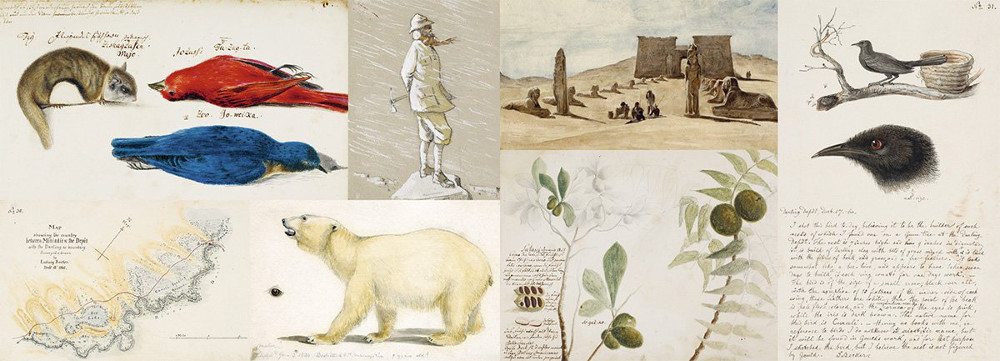
While the best way to see the world is in person with your own eyes, the next best thing is to look at and read accounts of people who have been there. And the history of some areas can only be learned from books, as they are countries whose time on this Earth was temporary, or still in flux. Chronicle Books has published two books that will help you see the world in a different light, all from the convenient location of your armchair.

Explorers’ Sketchbooks: The Art of Discovery & Adventure
Exploring the world isn’t a new pastime. It used to mean, though, that you had to board a ship, or ride in the back of a wagon, or procure a horse. It was a slow, usually arduous process that was often done as a solitary pursuit, because it was difficult to talk others into going with you. So, how could you best document or share your experiences and findings? There were no cameras, after all. You would have to write and draw what you saw. You would bring blank notebooks, pens, ink, watercolors, brushes, and other tools with you, and then hope that you would do it all justice on the notebook’s pages. These days, it’s comparatively easy to travel, and our photos of what we see can be transmitted across the globe in less than a moment. The world has been made smaller, but how often do we really see what we’re looking at? Snapping a photo for Instagram is fast. You don’t even have to be looking at what you’re capturing. But writing about, drawing, and painting what you see requires close study.
Pages from the notebooks of explorers from the past are shown in wonderful clarity in Explorers’ Sketchbooks. You don’t know the names of many explorers, you say? At least not ones who kept close record of their adventures? Well, you’ll definitely know some. James Cook. Charles Darwin. Meriwether Lewis. John James Audubon. Perhaps even Carl Linnaeus and Abel Tasman. But their names don’t matter. What they saw and recorded does.
This fairly large book (it’s 8″x11″x1.5″ with the binding on the 8″ side) includes profiles and pages from 70 explorers’ notebooks, 11 of them women, dating from the 1600s to modern day, many of which are generally hiding away in museums. The notebooks cover different climates and cultures, plants and animals, scenery and objects. All of the continents are represented, including the polar regions. The explorers themselves run the gamut from mapmakers to ecologists to anthropologists to botanists and more, and essays written by modern day explorers accompany these primary sources.
You’ll want to look closely at the book’s pages and revel in comparisons such as Galileo’s observation paintings of the phases of the moon and the recent images taken of Pluto by NASA’s New Horizons probe. You’ll see Darwin’s famous “tree of life” sketch and Maori tattoos drawn in great detail by Cook. Unusual bird and plant species. Painstaking notes written in sepia ink.
These explorer journals were how scientific discoveries and other cultures were documented, though often these journals were private and only meant for their creators’ eyes. Reading through this documentary book will give you a new appreciation for documentation, observation, art, and careful note taking. Read it cover to cover or jump around. But study the pictures, and be inspired to create your own explorer sketchbook.
Explorers’ Sketchbooks comes out today. Use it as an inspiration and resource for nature study, history, or geography. Or, just page through the book, pretending to be an explorer from a day gone by. It makes me want to round up a few art supplies and a leather-bound blank book, and disappear into the world for a time.

An Atlas of Countries that Don’t Exist: A Compendium of Fifty Unrecognized and Largely Unnoticed States
We might think we know what a country is, but the more we delve into different regions and tucked away areas of the planet, the more we learn that there are more spots with exceptions to the rules of what a “country” or a “state” should be than we might expect. An Atlas of Countries that Don’t Exist addresses 50 different countries around the world that don’t follow the rules.
From the Isle of Man to Elgaland-Vargaland (this is one you’ll have to read about to believe), we take an armchair voyage to 50 different countries that we may or may not already be familiar with. Some of these countries are delineated due to separatist movements, some due to border changes, and some are remnants of regime shifts, decades past. Others are islands with tenuous governments. And still others are entirely made up.

The book is divided up by continent, with countries that don’t exist listed from Europe, Africa, North America, South America, Asia, Oceana, and Elsewhere. But the one thing they all have in common is that they aren’t internationally recognized. You won’t find them around the table at the United Nations.
The section for each country includes their placement on a map, a page with the country’s shape die cut out of the page, their flag(s), when it was established (if it was) and dissolved (if it was), the capital, population, area, continent, and language(s). It also gives a brief history of the country, and how and why it was established and/or dissolved. Along the way, you learn tales of heroes, leaders, and questionable visionaries who affected the history of these fringe States.
Taking a round-the-world trip to learn about sometimes almost undefinable States and how some of them never quite fully came about can help peel back the layers of the formation timeline of other countries, those formally recognized by other nations around the world. From places that may be familiar, such as Tibet, Crimea, Rapa Nui (often referred to as Easter Island), and Greenland (yes, that Greenland), to those that may be new to you, such as Dinetah, Cabinda, and Forvik, once you read about these countries-that-aren’t-countries, your idea of a soveign land may change. It will be less cut and dry and more… fluid. It’s a useful exercise that I encourage everyone to go through. I learned so much about obscure bits of the world’s history, geography, and political history that I kept quoting tidbits to my family until they were sick of me.
An Atlas of Countries that Don’t Exist comes out today also. Read it and amaze your friends with geographical, political, and historical trivia they are unlikely to already know. It’s a perfect gift for those who love obscure facts.
Note: Copies of these books were provided for review purposes.


